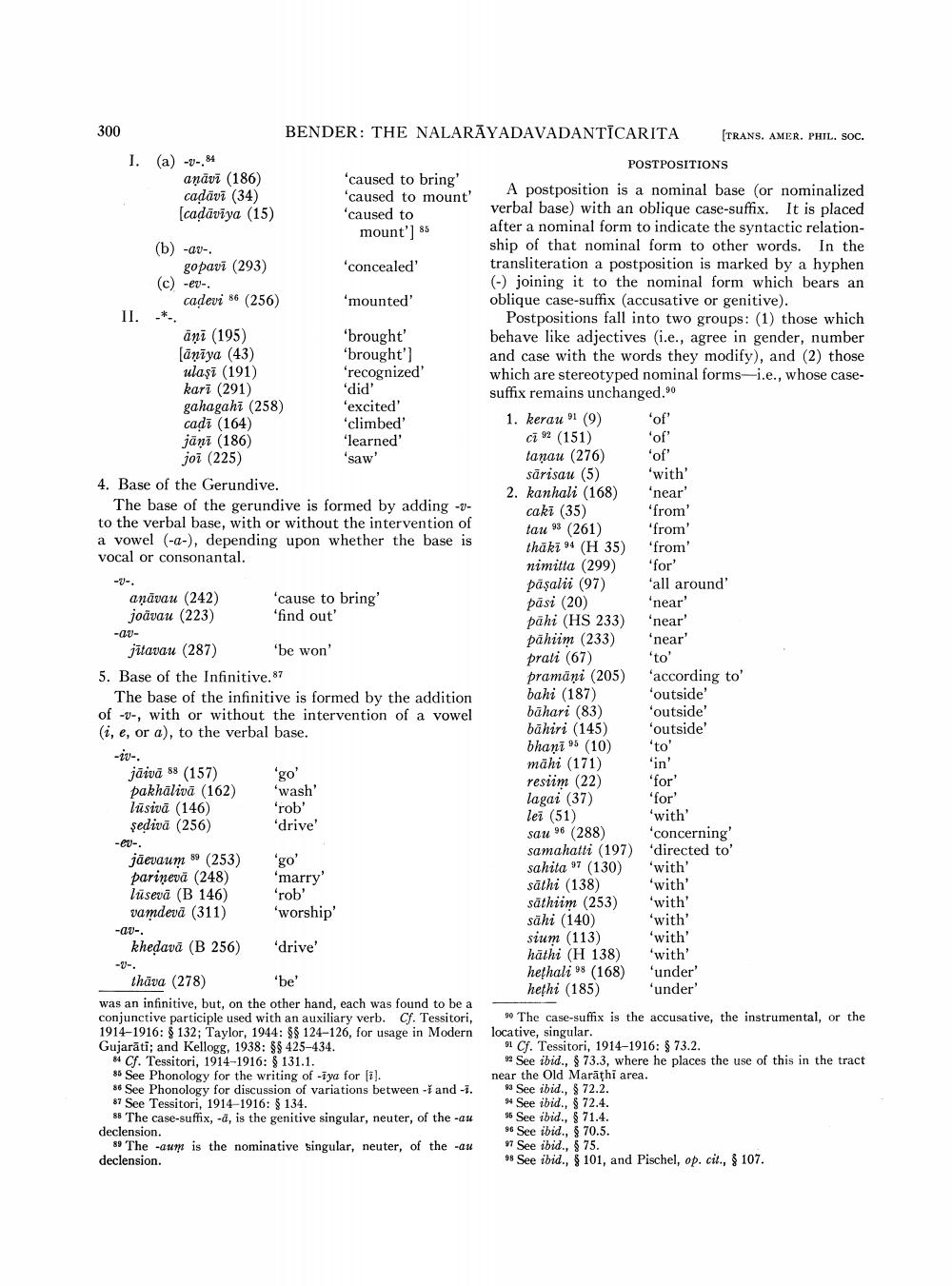________________
300
BENDER: THE NALARĀYADAVADANTICARITA (TRANS. AMER. PHIL. SOC. 1. (a) -v-,54
POSTPOSITIONS anāvi (186)
'caused to bring' cadāvi (34) 'caused to mount'
A postposition is a nominal base (or nominalized (cadāvīya (15) 'caused to
verbal base) with an oblique case-suffix. It is placed mount'] 85
after a nominal form to indicate the syntactic relation(b) -av
ship of that nominal form to other words. In the gopavi (293)
'concealed' transliteration a postposition is marked by a hyphen (c)-ev
(-) joining it to the nominal form which bears an cadevi 56 (256) 'mounted'
oblique case-suffix (accusative or genitive). II. *
Postpositions fall into two groups: (1) those which āņi (195)
'brought
behave like adjectives (i.e., agree in gender, number sānīya (43)
'brought')
and case with the words they modify), and (2) those ulaşi (191)
'recognized
which are stereotyped nominal forms-i.e., whose casekari (291)
'did'
suffix remains unchanged." gahagahi (258) 'excited' cadi (164) 'climbed
1. kerau 91 (9) 'of' jāņi (186) 'learned
ci 32 (151) 'of joi (225) "saw'
tanau (276) 'of'
sārisau (5) 'with 4. Base of the Gerundive.
2. kanhali (168) 'near' The base of the gerundive is formed by adding -Y
caki (35) 'from to the verbal base, with or without the intervention of
tau 93 (261) 'from a vowel (-a-), depending upon whether the base is
thāki 94 (H 35) 'from vocal or consonantal.
mimitta (299) 'for
päşalii (97) 'all around anavau (242) 'cause to bring'
pāsi (20) 'near' joavau (223) 'find out
pāhi (HS 233) 'near' -au
pāhiim (233) 'near jitavau (287) 'be won'
prati (67) 'to' 5. Base of the Infinitive.87
pramāņi (205) 'according to The base of the infinitive is formed by the addition
bahi (187) 'outside of -v-, with or without the intervention of a vowel bāhari (83) 'outside (i, e, or a), to the verbal base.
bāhiri (145) 'outside bhaņī 5 (10) 'to'
māhi (171) 'in' jāivā 88 (157) 'go'
'for
resiim (22) pakhāliva (162) 'wash'
lagai (37) 'for lūsivā (146) 'rob'
lei (51)
'with şedivā (256) 'drive'
sau 96 (288) 'concerning -eu
samahatti (197) 'directed to jāevaum 89 (253)
sahita 97 (130) with' parineva (248) 'marry'
sāthi (138) 'with' lūsevā (B 146) 'rob'
säthiim (253)
'with vamdevā (311) 'worship
sāhi (140) 'with' -av
sium (113)
'with' khedavā (B 256) 'drive'
hāthi (H 138) 'with
hethali 9 (168) "under' thāva (278) 'be'
hethi (185) "under' was an infinitive, but, on the other hand, each was found to be a conjunctive participle used with an auxiliary verb. Cf. Tessitori, 90 The case-suffix is the accusative, the instrumental, or the 1914-1916: $132; Taylor, 1944: $8124-126, for usage in Modern locative, singular. Gujarāti; and Kellogg, 1938: $$ 425-434.
91 Cf. Tessitori, 1914-1916: $ 73.2. *4 Cf. Tessitori, 1914-1916: $ 131.1.
92 See ibid., 873.3, where he places the use of this in the tract 85 See Phonology for the writing of -iya for (i).
near the Old Marāthi area. * See Phonology for discussion of variations between - and -1. 93 See ibid., $72.2. 87 See Tessitori, 1914-1916: $ 134.
94 See ibid., $72.4. 88 The case-suffix, -a, is the genitive singular, neuter, of the -au 95 See ibid., 71.4. declension.
96 See ibid., $ 70.5. 89 The -aum is the nominative singular, neuter, of the au 97 See ibid., $75. declension
98 See ibid., $ 101, and Pischel, op. cit., 8 107.
'go'




